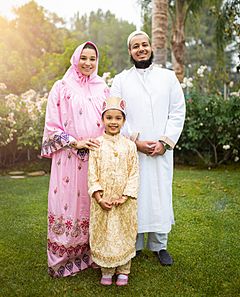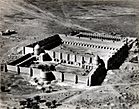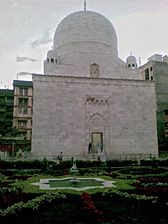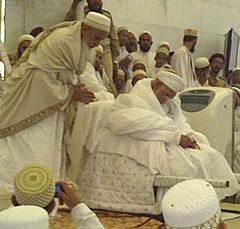Mohammed Burhanuddin facts for kids
Quick facts for kids Mohammed Burhanuddin |
|
|---|---|
| مُحـمّـد بـُرهـان الـدِّيـن | |
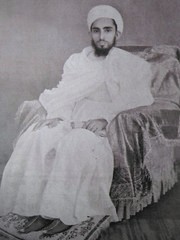
Burhanuddin c. 1934.
|
|
| Religion | Shi'a Islam |
| Sect | Ismailism Dawoodi Bohra |
| Other names |
|
| Personal | |
| Home town | Mumbai, India |
| Born | Mohammed 6 March 1915 Surat, Bombay Presidency, British India |
| Died | 17 January 2014 (aged 98) Malabar Hill, Mumbai, India |
| Resting place | Raudat Tahera, Mumbai |
| Spouse | Amatullah Aaisaheba |
| Children |
Daughters
Sakina
Batul Huseina Sons
Qaidjoher Ezzuddin
Mufaddal Saifuddin Malik ul Ashtar Shujauddin Huzaifa Mohyuddin Idris Badruddin Qusai Vajihuddin Ammar Jamaluddin |
| Parents |
|
| Senior posting | |
| Title |
|
Mohammed Burhanuddin (born March 6, 1915 – died January 17, 2014) was a very important leader for the Dawoodi Bohra community. He was their 52nd spiritual head, known as the Dā'ī al-Mutlaq. He led the community for 49 years. During his time, the community grew in many ways, including social life, money, and education. He helped bring back their old traditions and faith. He also made sure that traditional Islamic values and modern ways could exist together. Countries like Egypt and Jordan gave him high awards for his efforts. He was known as Azamat us-Sultan, which means "the Great Sovereign," in Arab countries. He was the first Dā'ī al-Mutlaq to visit Europe, Australia, and America.
Contents
His Life and Leadership
Early Years
Mohammed Burhanuddin was born in Surat, India. His father, Taher Saifuddin, was also a great leader.
Burhanuddin learned about his religion from his father. He finished his religious studies by age 13. When he was 15, he took an oath and was given important titles. He became Amir al-Hajj, meaning "chief of hajj pilgrims." He was also called Shaykh, meaning "leader," and Burhan al-Din, which means "proof of faith."
At 17, he was given a high rank called Haddiyah. He also became in charge of Alvazaratus Saifiyah, the main office for the community. When he was 19, his father chose him to be the next Dai al-Mutlaq. He was then made Mazoon al-Da'wat, which means he was his father's second-in-command. By age 20, Burhanuddin had memorized the entire Quran.
Family Life
Burhanuddin married Amatullah Aaisaheba in 1937 in Surat. She was from a respected family. The city and the main hall, Aljamea-tus-Saifiyah, were beautifully decorated for their wedding. His father invited all community members and important guests to the celebrations.
Burhanuddin and Amatullah had 10 children: seven sons and three daughters.
Becoming the Leader
After his father, Taher Saifuddin, passed away in 1965, Mohammed Burhanuddin became the new Dai al-Mutlaq. He chose a special place in Mumbai, called Raudat Tahera, for his father's burial. This place also has shrines of important figures like Imam Ali and Imam Husain.
Celebrating 100 Years
In 2011, Burhanuddin celebrated his 100th birthday according to the Islamic calendar. A huge parade took place in Mumbai with 8,000 people. People wore golden robes and rode horses or chariots. The parade showed all the good things he had done. Similar celebrations happened worldwide. During this time, he started a big building project in Mumbai called the SBUT project. He also announced a new branch of the Aljamea-tus-Saifiyah university in Nairobi, Kenya.
Choosing His Successor
Burhanuddin often visited London. In 2011, he became ill there. While in the hospital, he chose his second son, Mufaddal Saifuddin, to be his successor. He asked some family members to witness this, as is their tradition. He wanted this news shared with everyone.
When he returned to Mumbai, he went to his father's tomb. There, in front of thousands of people, he again announced Mufaddal Saifuddin as his successor. This event was also shown in other parts of Mumbai.
Community Activities
Special Dress Code
Burhanuddin asked male Bohras to grow beards and wear a white cap called a topi and a long shirt called a kurta. He asked women to wear a colorful two-piece dress called a Rida. This special dress, known as Libas al-Anwar, helps the community keep its unique Islamic identity. This tradition goes back to the Fatimid dynasty in Egypt.
Restoring Mosques
In 1980, Mohammed Burhanuddin beautifully restored the Al-Hakim mosque. He used white marble and gold. He also restored old carvings and writings. He wanted the mosque to be a place of worship again. He also restored the Great Mosque of Kufa in the 1990s.
Helping with Education
In 1999, Burhanuddin became the Chancellor of Aligarh Muslim University. His father had also held this position. He helped expand the Arabic university Al Jamea tus Saifiyah. In 1983, he built a new campus for "Al Jamea tus Saifiyah" in Karachi. He also created the "Burhaniyah Business Counseling Center" in Mumbai to help with modern business.
He built the Raudat Tahera in Mumbai, which is a tomb for his father. It is special because the entire Quran is written on its inner walls with gold and precious stones. India's President opened it in 1975.
In 1976, he started a center just for studying the Quran.
MSB Schools
MSB Schools (also called Al Madrasa Tus Saifiya Tul Burhaniyah) were started by Burhanuddin in 1984. The first schools were in Mumbai, India, and Nairobi, Kenya. These schools follow the Indian Certificate of Secondary Education and are run by the Dawoodi Bohra leader's office. There are now branches in 25 cities in India, Pakistan, East Africa, and the Middle East.
Aljamea-tus-Saifiyah University
Knowledge is our legacy. Hence, it is our duty to protect this legacy for the betterment of our community. The world is changing fast and, to live a respectable life, it is necessary for us to be aware of what’s going on around us; it is our duty to adapt to modern technology and industrial development.
On his 100th birthday, Mohammed Burhanuddin opened a third campus of Aljamea-tus-Saifiyah in Nairobi, Kenya. Two years later, his son Mufaddal Saifuddin opened another campus in Mumbai.
All four campuses are built around a mosque. Their buildings face the Holy Kaaba in Mecca. These campuses use green building methods. They use sunlight and natural air to save electricity. For example, they use solar water heaters. They also recycle, compost, and save paper.
Important Meetings
In 1978, Burhanuddin held a big Islamic meeting in Surat. He told community leaders to stick to their faith's traditions but also use new scientific discoveries. He also told them to stop charging riba, which means interest on loans. These meetings were held in different cities until 1988.
At the first meeting in Surat in 1978, Burhanuddin shared seven rules. These rules were to help his followers grow in social life, education, and business.
In 1984, he shared more rules. He especially focused on Qardan Hasana, which are loans given without interest. Getting rid of interest from community institutions was a big achievement of these meetings.
Community Kitchens
Burhanuddin started community kitchens called Faiz al-Mawaid al-Burhaniyah. These kitchens provide daily meals to Dawoodi Bohra families. This gives women more time for work, study, or religious activities. Everyone gets the same good, clean food, whether they are rich or poor. Community members can pay for their own family's meals or help pay for others who cannot afford it.
Medical Help
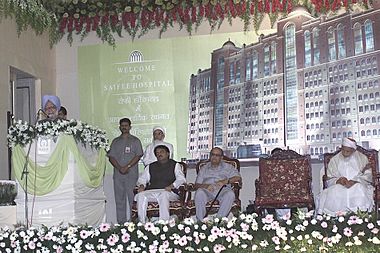
Saifee Hospital
Burhanuddin planned and built Saifee Hospital in Mumbai. It is a modern hospital with 250 beds. The Prime Minister of India, Manmohan Singh, opened it in 2005. Dr. Singh said the Bohra community made a great contribution to society by building this hospital.
The hospital aims to provide care for everyone. It has 2574 beds, 44 ICU beds, and 9 operating rooms. It performs about 10,000 surgeries each year. It is certified by international standards. The hospital specializes in robotic surgeries, heart care, and dentistry.
Burhani Medical Idara
Mohammed Burhanuddin also set up the Burhani Medical Idara (Department). This department helps Dawoodi Bohra community members with medical needs.
Their website has a list of doctors from the community who offer free services. As of 2019, over 2,500 doctors were registered. This means there is one doctor for every 300 community members.
Hospitals have also been built in places like Tanzania and Pakistan, where medical help is cheaper. Saifee Ambulance in Mumbai provides low-cost medical services to the local area. It helps with hospital stays, vaccinations, and blood donations. It also sets up regular health camps.
Community Development Project
One of Burhanuddin's biggest projects was starting the Saifee Burhani Upliftment Trust. This project is redeveloping 16.5 acres of land in South Mumbai. It includes about 250 old buildings, 1250 shops, and 3200 families. The goal is to replace old, rundown buildings with new ones, modern roads, open spaces, and businesses.
The project uses the best city planning ideas. It aims to meet the needs of people now and in the future. The area, known as Bhendi Bazaar, is divided into 7 smaller parts. Most people living in old flats will move into better new homes. The area will be eco-friendly with a sewage treatment plant, solar panels, rainwater harvesting, and trash disposal. It has already received a "Gold" rating for green buildings.
Memorizing the Quran
Burhanuddin strongly encouraged people to memorize the entire Holy Quran. He spoke about this at international events. In 1976, he started a Quranic institute called Mahad al-Zahra. Its main goals are to help people learn to recite, memorize, and understand the Quran.
Mohammed Burhanuddin opened Mahad al-Zahra in Karachi in 1984. In 1994, he gave a speech where he told students of Aljamea-tus-Saifiyah to memorize the whole Quran. The next year, his grandson, Husain Burhanuddin, memorized the entire Quran. Since then, many more have followed.
In 1998, Burhanuddin started a new Mahad al-Zahra in Surat, India. This place helps students focus on memorizing the Quran. It also has a studio where the entire Quran has been recorded and shared. Students from Aljamea-tus-Saifiyah teach community members worldwide. In 2013, a kindergarten called Rawdat al-Quran al-Kareem (RQK) was started in Mumbai to teach young children about the Quran.
Online Learning
In 2005, an online program was launched to help people memorize the Quran from far away places like Sydney, Australia, and Los Angeles.
Marriage Ceremonies
Burhanuddin continued his father's tradition of organizing large group weddings, called Rasm-e Saifee. These events happened when he visited different Dawoodi Bohra communities. A special committee, Taiseer un Nikah, helps people find partners, offers advice, and arranges these weddings.
Ashara Mubaraka
The Ashara Mubaraka (meaning "the blessed ten") is an annual event. It is a time of mourning for the martyrdom of Husayn ibn Ali at the Battle of Karbala. The Dai al-Mutlaq gives ten sermons over nine days. These sermons are about Islamic philosophy, history, and teachings. Each year, the Dai al-Mutlaq chooses a city to host the Ashara. Sometimes, 100,000 to 200,000 mourners attend. The sermons are often broadcast to other places around the world. People who travel for the event often receive free housing, transport, and meals.
His Teachings
Patriotism
Mohammed Burhanuddin always taught his followers to love and be loyal to the country they live in. He said that being loyal to your home country is a part of your faith in Islam. He told his followers to obey the laws and be good citizens. Because of this, Dawoodi Bohras have become well-connected in the countries where they live. They help in community efforts and social campaigns.
Islamic Identity
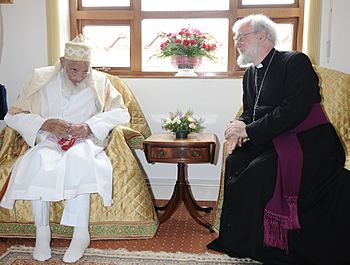
For 50 years, Mohammed Burhanuddin worked to give his followers a strong Islamic identity. The most noticeable part of the Dawoodi Bohra community is their religious clothing, called the Libas-al-Anwar (meaning "Radiant Clothes"). For men, it includes loose pants called an izar, a long shirt called a kurta, an overcoat called a saya, and a skull cap called a Topi. Women wear an all-covering dress called a Rida. Also, men in the community grow full beards, which adds to their unique look.
He also encouraged his followers to speak a special language called Lisan-al-Da’wah (the language of Da’wah). This language is mostly based on Arabic and Gujarati, with some words from Urdu and Persian.
Helping Others
Mohammed Burhanuddin often told his followers to help those who are less fortunate. In 2002, during a visit to Madagascar, he started the idea of "upliftment." He asked all community members to help each other. He also expanded his efforts to help society in general. For example, he provided aid after the Bombay Riots and the Bhuj earthquake.
During the holy month of Ramadan, less fortunate community members received important items like clothes, food, shelter, and medical services. To do this, Mohammed Burhanuddin set up organizations like the His Holiness Doctor Syedna Taher Saifuddin Memorial Foundation (STSMF).
Trade and Business
Mohammed Burhanuddin always encouraged his community to get involved in trade, business, and industry. The word "Bohra" itself means "a trader." He wanted his followers to grow their businesses. He stressed that they should keep the tradition of business and entrepreneurship alive. To help them, he started the idea of Islamic Loans, which are interest-free. These are called Qardan Hasanah (Good Loans).
In 1991, Mohammed Burhanuddin created the Burhani Qardan Hasana Trust. Its main goal is to give interest-free loans to community members to help them achieve their financial goals and expand their businesses. He also set up the Burhaniyah Business Counseling Centre (BBCC) in Mumbai to improve business skills. This center organized events called Burhani Expo to help community members connect and grow their businesses globally.
In 2014, Mohammed Burhanuddin updated this idea. He renamed the Qardan Hasana trust to Hasanaat al Qardan Hasan al Burhaniyah. The BBCC also became part of this new trust. A new department was formed to help entrepreneurs in the community. This department was named Tijarat Rabeha, which means "Profitable Business." It helps new and existing business people with modern solutions and ideas. It also holds seminars and workshops to help them improve their business skills.
Women's Welfare
In 1996, Burhanuddin created the Amatullah Aaisaheba Memorial Trust. He did this in memory of his late wife, Amatullah Aai, who was very active in helping Dawoodi Bohra women. The trust especially supports home businesses run by women.
Housing Projects
The community also helps provide affordable homes. Many housing complexes have been built across India, like in Kalyan and Marol. They have also been built in other countries, such as Nairobi, Kenya.
In 2004, a department called Faiz Enayat Amakene Anwar was started in Mumbai. Its main goal is to provide better living conditions for those living in poor areas.
Awards and Honors
- He received the Order of the Star of Jordan, which is Jordan's highest civilian honor.
- He also received the Order of the Nile, Egypt's highest civilian honor.
- He earned doctorates in Islamic Sciences from Al-Azhar University, in Theology from Aligarh Muslim University, and in Literature from the University of Karachi.
- In 2015, he was given the Padma Shri, India's fourth highest civilian award.
- He was listed among The 500 Most Influential Muslims from 2009 to 2013.
His Passing
Burhanuddin passed away from a heart attack at his home in Mumbai on January 17, 2014. The Bohra community held a 40-day mourning period. His second son and successor, Mufaddal Saifuddin, led his funeral prayer. Burhanuddin was buried at Raudat Tahera, next to his father. The Indian flag was flown at half-mast to show national mourning.
The day after he passed, many supporters gathered outside his home. Sadly, when the gates opened, a crowd surge happened, and eighteen people died. One year after his death, a memorial service in Mumbai brought together about three hundred thousand Bohras. Two special townships were built to house them.
Succession to Leadership
Mohammed Burhanuddin died in January 2014. According to their traditions, each leader must name his successor during his lifetime. After his death, there was a disagreement over who should be the 53rd Dā'ī al-Mutlaq. His son, Mufaddal Saifuddin, and his half-brother, Khuzaima Qutbuddin, both claimed the title.
Most of the community supported Mufaddal Saifuddin, while a smaller number supported Khuzaima Qutbuddin. Mufaddal Saifuddin took control of the Dawoodi Bohra community's operations. Governments and other public groups widely accept him as the Bohras' leader. The UK Charity Commission has also stated that Mufaddal Saifuddin is the current leader.
Family History
Burhanuddin's family line includes important leaders of the early Fatimid mission in India. These include Fakhr al-Din Shaheed, Abd al-Qadir Hakim al-din, Khanji Pheer, and Syedi Lukman.
Important Writings
Rasāʾil Ramaḍāniyya (Epistles)
Mohammed Burhanuddin wrote a series of important religious letters called Risalah Ramadaniyya. Each letter is given a title based on the Abjad numerals for the Hijri year it was published.
| ID | Title | Title (English) | Hijri | Pub. | Year |
|---|---|---|---|---|---|
| SMB 00 | حكمة الغيبة الحقيقية | Hikmat al-Ghaybah al-Haqiqiyyah | 1385H | ||
| SMB 01 | استفتاح زبد المعارف | Isteftah Zubad al-Ma'arif | 1385H | 1386H | |
| SMB 02 | فيوضات الجنة | Fuyoodhaat al-Jannah | 1386H | ||
| SMB 03 | سلام نضرة النعيم | Salaam Nadrah al-Na'eem | 1387H | ||
| SMB 04 | ذات النور | Zaat al-Noor | 1388H | ||
| SMB 05 | ظهور مجد الفاطميين | Zuhoor Majd al-Fatimiyeen | 1389H | ||
| SMB 06 | بركة صبغة الله | Barakah Sibghah Allah | 1390H | ||
| SMB 07 | نشر الخير | Nashr al-Khayr | 1391H | 1437H | 2017 |
| SMB 08 | ندى الفيوضات | Nadā al-Fūyūdāt | 1392H | 1438H | 2018 |
| SMB09 | سلسبيل روض القدس | Salsabīl Rawd al-Quds | 1393H | 01.10.1439H | 2019 |
| SMB10 | بركات دعاة الستر | Barakāt Duāt al-Satr | 1394H | 01.10.1440H | 2020 |


